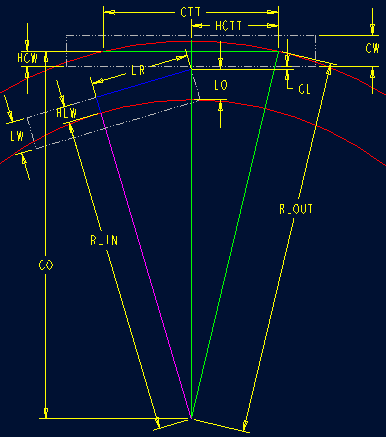When cars and locomotives go around curves, they overhang the track. On my layout, the worst overhang towards the inside of curves will be from the 85 foot passenger cars used on the Pere Marquette's streamlined trains. The worst overhang towards the outside of the curves will be caused by the cab's of my Berkshire locomotives. Below is a line schematic of the worst case scenario of a long passenger car on the outside track and a rigid wheelbase non-articulated locomotive on the inside track.

CTT = car truck to truck distance
HCTT = half the car truck to truck distance
CW = car width
HCW = half the car width
LR = distance between the center of the locomotive's rigid wheel base and the end of the cab
LW = locomotive width
HLW = half the locomotive width
R_IN = inside track radius
R_OUT = outside track radius
CL = minimum desired or acceptable clearance
CO = car offset
LO = locomotive offset
Using the Pythagorean theorem, the following equation can be written and solved for CO:
CO2 + HCTT2 = R_OUT2
CO2 = R_OUT2 - HCTT2
CO = sqrt(R_OUT2 - HCTT2)
R_IN can be defined as follows:
R_IN = CO - HCW - CL - LO
Plug in CO and solve for LO:
R_IN = sqrt(R_OUT2 - HCTT2) - HCW - CL - LO
LO = sqrt(R_OUT2 - HCTT2) - HCW - CL - R_IN
Using the Pythagorean theorem, the following equation can be written:
LR2 + (R_IN + HLW)2 = (LO + R_IN)2
Plug in the previously derived equation for LO and solve for R_IN:
LR2 + (R_IN + HLW)2 = (sqrt(R_OUT2 - HCTT2) -HCW - CL -R_IN + R_IN)2
LR2 + (R_IN + HLW)2 = (sqrt(R_OUT2 - HCTT2) -HCW - CL)2
(R_IN + HLW)2 = (sqrt(R_OUT2 - HCTT2) -HCW - CL)2 - LR2
R_IN + HLW = sqrt((sqrt(R_OUT2 - HCTT2) -HCW - CL)2 - LR2)
R_IN = sqrt((sqrt(R_OUT2 - HCTT2) -HCW - CL)2 - LR2) - HLW
Now, given the constants of HCTT, HCW, CL, LR, and HLW, for any outside radius, the inside radius can be calculated. Of course, the distance between the track centerlines should never be less that the standard tangent (straight) track clearance.
Here is a Microsoft Excel spreadsheet that you can use to generate your own table of inside radii relative to outside radii.